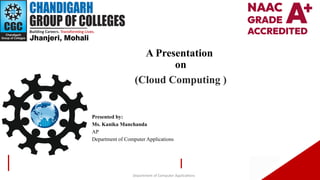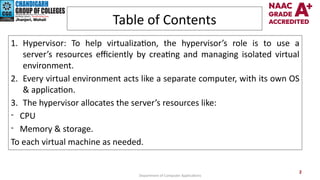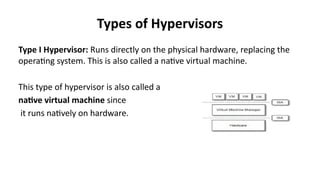Cloud computing 10 lecture class notes, full lecture notes
- 1. 1 A Presentation on (Cloud Computing ) Presented by: Ms. Kanika Manchanda AP Department of Computer Applications Department of Computer Applications
- 2. Table of Contents 1. Hypervisor: To help virtualization, the hypervisor’s role is to use a server’s resources efficiently by creating and managing isolated virtual environment. 2. Every virtual environment acts like a separate computer, with its own OS & application. 3. The hypervisor allocates the server’s resources like: - CPU - Memory & storage. To each virtual machine as needed. 2 Department of Computer Applications
- 3. Types of Hypervisors • There are two major types of hypervisors 1. Type I 2. Type II
- 4. Types of Hypervisors Type I Hypervisor: Runs directly on the physical hardware, replacing the operating system. This is also called a native virtual machine. This type of hypervisor is also called a native virtual machine since it runs natively on hardware.
- 5. Types of Hypervisors • Type II Hypervisor: Runs on top of an existing operating system, using it to manage virtual machines. It is also called a hosted virtual machine because it relies on the host OS. This type of hypervisor is also called a hosted virtual machine since it is hosted within an operating system.
- 6. Difference Feature Xen VMware Microsoft Hyper-V Type Open-source hypervisor Commercial hypervisor with several products Commercial hypervisor integrated with Windows Server Usage Commonly used in large-scale cloud environments (e.g., AWS) Widely used in enterprises for server and desktop virtualization, with various products for different needs Often used in Windows environments; integrates well with other Microsoft services and tools Management Dom0 (Domain 0) manages resources, drivers, and other VMs VMware vSphere provides centralized management for multiple VMs Managed using Hyper-V Manager or System Center for multiple servers Performance Efficient for large cloud environments, good isolation between VMs High performance with strong enterprise features, especially in VMware ESXi Good performance, especially in Windows-centric environments Compatibility Works well with various Linux distributions and some other OSes Supports a wide range of operating systems, including Windows and Linux Best integrated with Windows OS, but also supports Linux Cost Free and open-source, though commercial support is available Typically requires purchasing licenses for various products Requires Windows Server licenses, which can be costly
- 7. Xen • The Xen hypervisor is software that manages virtual machines on a server. • Sits between the hardware and the operating systems, managing and dividing resources. • Allowing multiple operating systems to run on the same server simultaneously • In the context of the Xen hypervisor, the concept of "rings" refers to different levels of privilege in the system. 7 Department of Computer Applications
- 8. Difference between rings Ring Level Description Role in Xen Hypervisor Access Level Ring 0 Highest privilege level Runs the Xen hypervisor itself. Has direct access to hardware. Full hardware access. Ring 1 Intermediate privilege level Not typically used in Xen. Not applicable. Ring 2 Intermediate privilege level Not typically used in Xen. Not applicable. Ring 3 Lowest privilege level Runs guest operating systems (VMs). Limited access to hardware. Restricted access via hypervisor.
- 9. Xen Architecture Overview • Xen Hypervisor: Runs in the highest privilege mode and manages access to hardware for guest operating systems. • Guest Operating Systems: Run in virtual machines called domains. • Domain 0: A special domain with control over the system, used to create, configure, and manage other virtual machines. It also hosts an HTTP server for these tasks. • Rings: x86 systems use different security levels, called rings, to manage permissions.
- 10. Pros of Xen • Flexible and Efficient: Uses both hardware and software virtualization for better performance and flexibility. • Workload Management: Handles large workloads well, optimizing CPU, memory, and network usage. • Storage Integration: Works with major storage systems like HP, NetApp, and Dell. • Features: Supports multiple processors, live migration, conversion tools, centralized management, and real-time monitoring for Windows and Linux.
- 11. Cons of Xen • Better on Linux: More reliable with Linux than Windows. • Third-Party Dependence: Relies on external tools for managing resources like drivers and storage. • Deployment Issues: Can be complex and burdensome on Linux systems over time. • Resource Overhead: High input-output rates may impact resource availability for other virtual machines.
- 12. Full Virtualization with VMware • Concept: Full virtualization replicates hardware so the guest OS can run without changes, as if it’s on real hardware. VMware: Uses full virtualization for both desktops (Type-II hypervisor) and servers (Type-I hypervisor). How It Works: For x86 architecture, VMware handles instructions directly if they’re not sensitive, and uses binary translation(0,1) for sensitive instructions. This allows the OS to run without modifications.
- 13. VMware Hypervisor (used similarly to describe different levels of privilege) Ring Level Description Role in VMware ESXi Access Level Ring 0 Highest privilege level Runs the VMware ESXi hypervisor itself. Has direct access to hardware. Full hardware access. Ring 1 Intermediate privilege level Not typically used in VMware ESXi. Not applicable. Ring 2 Intermediate privilege level Not typically used in VMware ESXi. Not applicable. Ring 3 Lowest privilege level Runs guest operating systems (VMs). Limited access to hardware. Restricted access via hypervisor.
- 14. Pros • Windows Integration: Works well with Windows Server and Microsoft tools, ideal for Windows-focused environments. • Cost-Effective: Included with Windows Server licenses, saving money compared to other virtualization options. • Supports Many OSes: Compatible with various Windows and Linux versions. • Live Migration: Moves virtual machines between servers with little downtime.
- 15. Cons • Linux Setup Complexity: Setting up Linux VMs can be more difficult compared to other platforms. • Hardware Needs: Requires specific hardware features, which might not work with older equipment. • Licensing Costs: Additional costs for Windows Server and management tools.
- 16. Microsoft Hyper-V • Microsoft Hyper-V is a virtualization technology developed by Microsoft that allows you to create and manage virtual machines (VMs) on Windows-based servers. It's commonly used in data centers, enterprise environments, and cloud services to consolidate workloads, optimize resource use, and provide flexible virtualization solutions.
- 17. Difference Ring Level Description Role in Hyper-V Access Level Ring 0 Highest privilege level Runs the Hyper-V hypervisor itself. It has full control over the hardware and manages virtual machines. Full hardware access. Ring 1 Intermediate privilege level Not used in Hyper-V. Typically, this level might be used for device drivers or similar tasks in other systems. Not applicable. Ring 2 Intermediate privilege level Not used in Hyper-V. Similar to Ring 1, it’s not utilized for typical operations in Hyper-V. Not applicable. Ring 3 Lowest privilege level Runs guest operating systems (VMs). They operate with restricted access and rely on Hyper-V for hardware interaction. Restricted access via hypervisor.
- 18. Pros • High Availability: Automatically moves VMs if a server fails to ensure continuous operation. • Hyper-Converged Infrastructure: Works with solutions like Azure Stack HCI for combined storage and networking. • Management Tools: Managed through Hyper-V Manager and can be enhanced with System Center Virtual Machine Manager.
- 19. Cons • Fewer Add-Ons: Fewer third- party tools and extensions compared to other virtualization solutions like VMware. • Learning Curve: May be complex for those new to the platform
- 20. THANK YOU 20



















